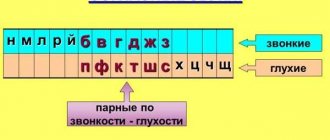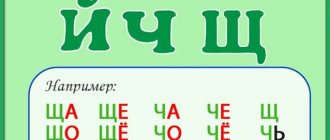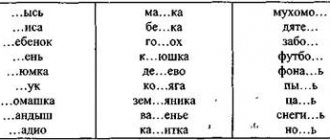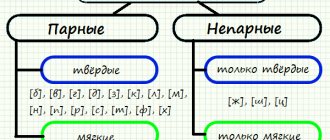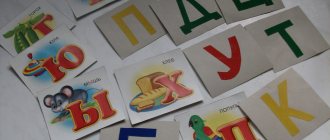Lesson summary “Hard and soft consonant sounds and letters to denote them”
Lesson topic: “Hard and soft consonant sounds and letters to denote them”
Lesson type: reflection lesson
The purpose of the lesson:
consolidate acquired knowledge on the topic “
Hard and soft consonant sounds and letters to denote them
”
Lesson steps
1. Stage of motivation (self-determination) for correctional activities
Goal: creating conditions for the emergence of an internal need for inclusion in activities.
-The bell gave us a signal, the hour has come to work. So we don’t waste time, and let’s start working.
- Look at your desks, is everything ready for the lesson? (notebooks, textbook, pencil case, colored pencils, reflection sheet)
-Guys, there are emoticons on your desks, let’s evaluate the mood in which you came to class!
-Pick up the emoticon that matches your mood.
2. Stage of actualization and trial educational action
Goal: preparing students’ thinking and their awareness of the need to identify the causes and difficulties in their own activities
-Open the notebooks. Write down the number, great job.
-Read the words written on the board.
Blizzard, ten, lilac
— Write these words in your notebook
- What unites these words? (Tell me, when you read these words, what did you notice?)
-Take a green pencil and mark all the soft consonant sounds.
- Let's remember and draw a conclusion: if after a consonant there is a soft sign or letters: i, i, yu, e, e, then the consonant sound becomes soft.
-Evaluate, on the reflection sheets, how you wrote down the number, class work, and words.
Let's formulate our goal: to consolidate the knowledge gained on the topic “Hard and soft consonant sounds and letters to denote them”
- Guys, look who came to visit us, what cartoon hero Olaf is the snowman from the cartoon “Frozen”.
-Look what happened to our board with his arrival? He covered our board with snowflakes, look, these are not just snowflakes with something written on them, let's take a look.
-He prepared tasks for us
3. Stage of localization of individual difficulties
Goal: awareness of the place and causes of one’s own difficulties in performing the learned methods of action.
-Guys, listen to what you will do: I will give you snowflakes with the tasks that Olaf gave me, which you will complete in notebooks yourself. After completing the task, put your pens on the table.
Snowflake No. 1
1. Write it down. Fill in the missing letters. Underline the consonants that represent soft sounds with a green pencil and hard sounds with a blue pencil.
February, January, December, February, furniture, magazine, metro.
Snowflake#2
1.Copy down.Insert the missing letters. Use a green pencil to underline the letters that represent soft consonants.
Watering can, true story, skates, days, forest, honey, chandelier, pulp.
Snowflake No. 3
1. Write it down. Underline the letters that represent soft consonants with a green pencil, and the hard ones with a blue pencil.
Days, motley, slush, chandelier, summer, necklace.
Snowflake#4
- Write down the names of objects that begin with a soft consonant sound.
Snowflake No. 5
1.Write down words that begin with a soft consonant sound. Underline the soft consonants with a green pencil.
Winter, soap, cart, horse, umbrella, raft, honey.
Physical education minute
- Guys, it's time to rest, let's get up. - If you hear the first sound soft, squat, if hard, jump.
Feast, cat, nanny, steam, chalk, heat, forest, house, cheese, drank, floor.
Winter, snow, blizzard, bullfinch, snowman, blizzard.
Well done! Have a seat!
4. The stage of constructing a project to correct the identified difficulties.
Goal: setting personal goals for correctional activities, choosing the method and means of its implementation
-Let's talk about the plan according to which you completed your task.
Draw up a work plan:
1. Read the task
2. We pronounce the word or the name of the object to ourselves (or in a whisper)
3. Find letters that give softness or hardness to the preceding consonant sound
4. Mark the soft consonant sound with green, and the hard consonant sound with a blue pencil.
5. Implementation stage of the completed project.
Goal: meaningful correction by students of their mistakes in independent work, developing the ability to correctly apply appropriate methods of action
-Look at the board and check your work yourself against the standard; to do this, take a simple pencil; if you make mistakes, correct them.
In the margins, if we put everything correctly + if there are errors, we put it!
6. Stage of generalization of difficulties in external speech
Goal: generalization of difficulties in oral speech, consolidation of methods of action that caused difficulties
-Guys, it seems Olaf wants to tell us something:
- “Guys, I think I understand how to find soft consonants. And you?"
-Let's clarify in the textbook. S 121 Remember!
-Remember the plan that we drew up and one of the points was:
We find letters that give softness or hardness to the preceding consonant sound
7. Stage of independent work with self-test according to the standard.
Goal: self-test and individual reflection on achieving the goal and creating a situation of success
-Guys, look, Olaf has prepared another task for us: “let’s do a little magic, make soft consonants out of hard consonants. Write down only the new version of the words.”
Sample: soap - mil
Nose, steam, onion.
-Check against the standard whether you have written down the words correctly. If there are no errors, then put a plus, in the snowflake, if there are errors, put an exclamation mark.
Complete the task, taking turns going to the board.
8. Stage of inclusion in the knowledge system and repetition.
Goal: repetition and consolidation of previously learned
-Guys, Olaf invites us to turn to the textbook and complete the task on p. 122 exercise 198
If someone has forgotten unpaired consonant sounds, where can we look them up?
Let’s check this task together. I read the correct answer, and you put “+” next to it if it’s true and “–” if it’s false.
Do the task from the textbook
Do a self-test together with the teacher
9. The stage of reflection of educational activities in the lesson.
Goal: awareness of the method of overcoming difficulties and self-assessment of the results of their correctional activities
— Our lesson is coming to an end. What was the purpose of the lesson? Have we achieved our goal? -Raise your hand those who can say about themselves: “I have learned to distinguish between hard and soft consonant sounds.”
-In the reflection sheets, evaluate your work in the lesson, paint over a large snowflake - if you think that you have reached the mark of 5 or 4, a small one if 3 or 2.
Grading with teacher adjustments.
-Let's write down the homework p.123 exercise 201.
Optional additional task: write a fairy tale about how hard consonant sounds turn into soft consonant sounds.
-Guys, raise a smiley face and tell us in what mood you will leave the lesson!
-Thank you for the lesson!
| Snowflake No. 1 1. Write it down. Fill in the missing letters. Underline the consonants that represent soft sounds with a green pencil and hard sounds with a blue pencil. February, January, December, February, furniture, magazine, metro. | Snowflake#2 1.Copy down.Insert the missing letters. Use a green pencil to underline the letters that represent soft consonants. Watering can, true story, skates, days, forest, honey, chandelier, pulp. | Snowflake No. 3 1. Write it down. Underline the letters that represent soft consonants with a green pencil, and the hard ones with a blue pencil. Days, motley, slush, chandelier, summer, necklace. |
Snowflake#4
| Snowflake No. 5 1.Write down words that begin with a soft consonant sound. Underline the soft consonants with a green pencil. Winter, soap, cart, horse, umbrella, raft, honey. | Snowflake No. 1 1. Write it down. Fill in the missing letters. Underline the consonants that represent soft sounds with a green pencil and hard sounds with a blue pencil. February, January, December, February, furniture, magazine, metro. |
| Snowflake#2 1.Copy down.Insert the missing letters. Use a green pencil to underline the letters that represent soft consonants. Watering can, true story, skates, days, forest, honey, chandelier, pulp. | Snowflake No. 3 1. Write it down. Underline the letters that represent soft consonants with a green pencil, and the hard ones with a blue pencil. Days, motley, slush, chandelier, summer, necklace. | Snowflake#4
|
How to distinguish a hard and soft consonant?
To find out whether a consonant is hard or soft, first pronounce the word and listen to how the sound being studied sounds:
- var [in] - fork [in']
- sign [z] - basket [z']
- catfish [s] - gray [s']
- good [x] - cunning [x']
Let’s also take into account that in written speech the consonants after which the letters are written are soft:
1. “e”, “e”, “i”, “yu”, “i”:
- white [b' e l y']
- motley [p' o s ry y']
- sled [s a n k'i]
- glass [r' u m k a]
- lethargic [v' a l y']
2. The softness of many consonants, except for the unpaired [zh], [sh], [ts], [h'] and [sh'], expresses “b”:
- big [l']
- seven [m']
- tablecloth [t']
- struggle [r'].
Let us take into account that “b”, which is written after the always hard hissing “zh”, “sh”, does not serve to soften them, but to denote feminine nouns of the third declension or verb forms:
- trembling [f]
- gouache [w]
- eat [w]
- cover up [f]
- don't worry [f].
3. Consonants in a combination of several sounds can be soft in sound if the subsequent soft consonant influenced the previous one. This phonetic process of softening a consonant depending on its position in a word is called assimilation based on hardness/softness, or assimilation (Latin assimilatio - “likeness”).
Let's see how consonant sounds influence each other:
- pension [p' e n' s' and j' a]
- bathhouse attendant [b a n' sch' and k]
- donut [p o n' h' and k]
- disease [b a l' e z' n']
- bones [k o s' t'i]
Please note that this phonetic sound of soft consonants is not reflected in written speech.
In accordance with the spelling rule, a soft sign is not written in conjunction with the consonants nch, chk, chn, rshch, rch, etc.
Paired hard and soft consonants
In Russian, most of the same consonants can be either hard or soft. They form pairs with each other, correlating on the basis of hardness/softness.
Consonants correlating on the basis of hardness and softness are paired. With their help, you can distinguish words with different lexical meanings:
- be [b] - beat [b']
- howl [v] - curl [v']
- pole [t] - six [t']
- lot [lot] - ice [l' o t].
But some sounds of the Russian language do not have corresponding paired hard or soft consonants.
